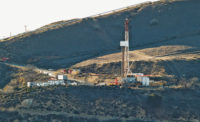A permanent end to a seemingly endless torrent of oil gushing from a runaway well in the Gulf of Mexico appeared in sight in mid-July as BP successfully installed a sealing cap on the wellhead—a crucial step in shutting it down. The cap was bolted on even as a drilling crew was coming close to intersecting
the well bore almost 13,000 ft below the seabed with one of two relief wells being drilled nearby. Their aim is to pierce the well bore and kill the well by choking it with drilling mud and cement.
BP is owner of the Macondo well, which has been gushing an unknown quantity of oil into the Gulf since the Deepwater Horizon drilling rig exploded and sank on April 20, killing 11 crewmen. Estimates of the flow from the well range from 35,000 to 60,000 barrels per day.
On July 12, BP reported that it successfully had replaced a loosely fitting cap that was settled over the damaged wellhead weeks ago in an attempt to capture some of the spewing crude. BP replaced the loose cap with a 30-ft-tall, 80-ton sealing cap equipped with three rams—essentially a cap with a modified blowout preventer. It has the potential to keep all oil out of the Gulf until one of the completed relief wells permanently seals the flow.
The multistep procedure required months of preparation, construction and practice. Remotely operated vehicles first straightened the top of the sheared-off riser, which was leaning about 3 degrees. Then ROVs removed six 52-lb bolts from a flange on top of the existing BOP.
Next, a tool was lowered from a riser pipe aboard a ship on the sea surface, 5,000 ft above, to grab and remove the old flange. A new connector then was lowered from the ship and put in place by an ROV. Once in place, that connector provided an attachment point so the sealing cap could be lowered and connected to the old riser pipe and BOP.
After the cap was installed—two to five days faster than expected—BP used valves and kill lines on the cap to temporarily stop the oil flow from the well.
Up to 48 hours of integrity tests are planned to verify that oil is not coming up from some other point of damage in the well or reservoir.
The U.S. Coast Guard incident response commander, Adm. Thad Allen, says crews are hoping to hold 8,000 to 9,000 psi for at least six hours to prove the integrity of the well. If the tests show pressures between 4,000 to 6,000 psi, it would indicate that oil is going “somewhere else.” If the pressure tests are good, though, the preference will be to “shut in” the well, says Kent Wells, BP’s senior vice president. “If we can shut in the well, we will shut in the well,” he says.
If the pressure is not high enough to assure engineers the well bore is sound, however, BP has installed one floating riser pipe and is installing a second. The riser pipes can continue to take oil from the well. If necessary, a new “top hat,” or containment dome, can be placed on the sealing cap to help remove oil as well.
BP says it now has the capacity at the surface to collect up to 33,000 bpd, and that capacity will increase to 60,000 to 80,000 bpd within two or three weeks. The company was collecting about 25,000 bpd under the loose-cap system, for a total of 779,000 barrels so far. There are no good measurements on how much oil has flowed from the well.
BP still plans to kill the well at the reservoir by stopping it with drilling cement. Then, “It can’t ever flow again to the surface,” says Doug Suttles, BP’s chief operating officer.
On July 12, Platts Oilgram News, a publication owned by ENR’s parent, The McGraw-Hill Companies, reported some of BP’s customers don’t want the recovered oil anyway, citing legal concerns. Others question the unproven quality of the recovered Macondo oil.
On July 13, the first relief well was within 200 ft of its target. Suttles said, in the best case, that relief well could be complete by the end of July, although Wells says he expects the operation actually will take until early August because of the difficulty of a “9-inch [drilling pipe] hitting a 9-inch hole,” 18,000 ft below the surface.
The worst-case scenario is a grim one: a botched well bore or pressure test that pierces the seabed floor, punching through to the vast oil reservoir. Either mistake could exponentially expand an environmental nightmare.










Post a comment to this article
Report Abusive Comment